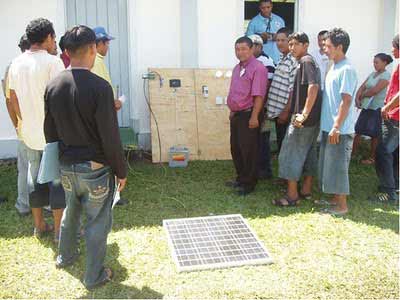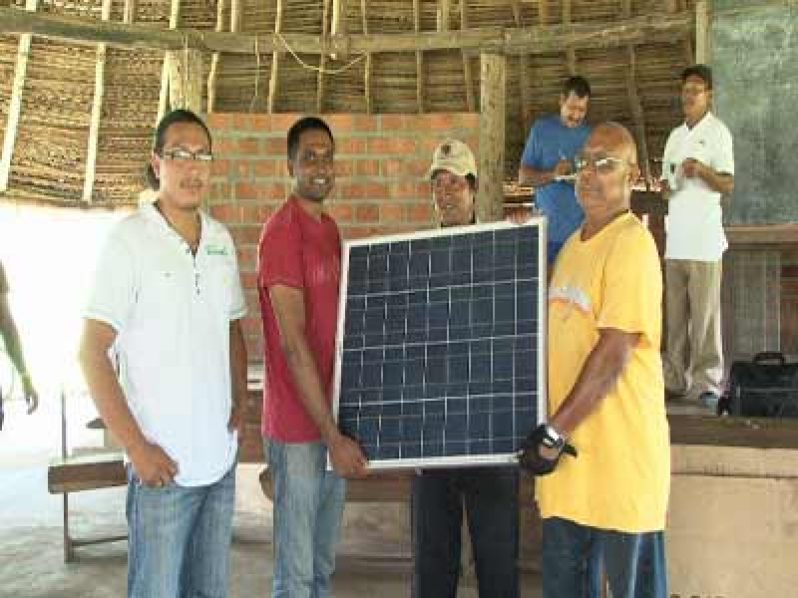In many developing countries, interior and remote areas are without electricity and, while the population has need for services powered by electricity, governments, however find it difficult to serve these mostly small populations because of their geographic locations and topography.
Here in Guyana, the Administration has long recognised that due to communities’ locations, it is difficult to link them to the national grid, as such it has come up with the Hinterland Electrification Programme (HEP) that targets Amerindians who mostly occupy the interior locations.
 Having grown out of the Unserved Areas Electrification Programme (UAEP), this project targets distribution of 11, 000 solar home systems which were sourced last year and distribution had begun since then. Distribution has been fast-tracked and soon all the home systems would be distributed.
Having grown out of the Unserved Areas Electrification Programme (UAEP), this project targets distribution of 11, 000 solar home systems which were sourced last year and distribution had begun since then. Distribution has been fast-tracked and soon all the home systems would be distributed.
Implementation of the HEP is linked to the Amaila Falls Hydropower project which is a major aspect of the Low Carbon Development Strategy (LCDS).
Government was aware that there were many people on the Coast who wanted to access electricity from the national grid, but did not have wherewithal to do so. “So we worked and got loan financing to support the extension of electrification, mainly on the coastland areas and along the rivers, for the potential of about 40,000 households who would need electricity,” Prime Minister Samuel Hinds, who has responsibility for the energy sector sa
Having grown out of the Unserved Areas Electrification Programme (UAEP), this project targets distribution of 11, 000 solar home systems which were sourced last year and distribution had begun since then. Distribution has been fast-tracked and soon all the home systems would be distributed.
Implementation of the HEP is linked to the Amaila Falls Hydropower project which is a major aspect of the Low Carbon Development Strategy (LCDS).
Government was aware that there were many people on the Coast who wanted to access electricity from the national grid, but did not have wherewithal to do so. “So we worked and got loan financing to support the extension of electrification, mainly on the coastland areas and along the rivers, for the potential of about 40,000 households who would need electricity,” Prime Minister Samuel Hinds, who has responsibility for the energy sector sa
“Simultaneously, it was decided that “all of our people across the country should have some degree of electrification,” he stated, and thus was born the hinterland component.
Four villages were then provided with photo-voltaic solar home systems which consisted of a panel, control circuitry and a battery, with some lights at each household. “As the project moved along, we were able to reconfigure it from time to time, and so actually did about 16 villages and about 1500 households all across the country. We also put in a mini-grid at Mahdia and Port Kaituma and we largely redid also the grid work at Lethem,” he explained.
For homes that are more than 100 metres apart, studies of the photovoltaic solar home systems showed them the most appropriate for use, thus the move to put the units in 160 or more villages across the country. Each unit has a 65W panel, a battery, a controller and some lights. The project is more than 50% complete.
The Guyana Power and Light (GPL) grid essentially generates 5mgw /8mgw units, and puts out feed into a network which connects into a home on its grid. In the hinterland, homes are further apart and such an approach is not economical. “The cost is approximately $3M to get to a house a mile away, so grids in areas where buildings are far apart are extremely expensive. The PV system is in that situation less costly,” he stated. A 65W collector and six hours a day of full collection would accumulate about 10 to 12 kw hours per month. Energy saving bulbs would provide sufficient lighting in those circumstances. On the GPL grid the cost would be approximately $1,000 for 12 KW of electricity.
A 65W collector and six hours a day of full collection would accumulate about 10 to 12 kw hours per month. Energy saving bulbs would provide sufficient lighting in those circumstances. On the GPL grid the cost would be approximately $1,000 for 12 KW of electricity.
Under the solar panel project, hinterland residents will not be paying, however, they are expected to make a self sustaining contribution for the replacement of bulbs and batteries and maintenance. The sum of $500 per month into a fund to be managed by the villagers will ensure money to sustain the system.
The home systems can provide power for lighting, and operation of small household appliances such as sewing machines and radios.
Horace Williams, CEO of the HEP reported that Region 9 distribution is almost completed while Regions One and Two are completed. Work is progressing on Seven, Eight and Ten, in addition to the other smaller regions in terms of hinterland communities, Four, Five and Six.
Following the completion of the distribution process, visits to communities will determine the status of the installation and provide guidance and support.
Members of the community will be doing the installation work, and a training programme has seen 372 persons, two from each village trained from 186 villages. These persons are expected to spearhead the installation with support from other village members who would also have acquired some assembling installation skills by working along with the trained persons. In effect at least 10 persons within each village will have knowledge of installation and the operations of the system and could provide some support when there is a fault within any community.
Additionally, each of the two trained persons will be given a tool kit including multi testers, and two ladders with a total worth of approximately $200,000. The individuals who are trained and equipped are to do installations at no charge to residents, since they will be paid by the programme $3,000 per household.



.jpg)








